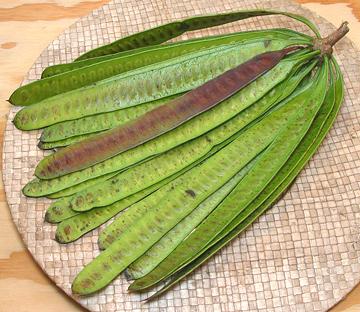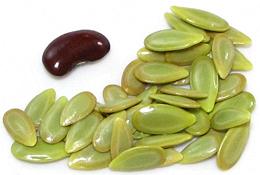Guaje
 [Jumbay, White Leadtree, White Popinac; Guaje (Spanish); Huaxim
(Mayan (say "washim")); Huaxcuahuitl (Nahuatl); Phakatin (Thai);
Leucaena leucocephala]
[Jumbay, White Leadtree, White Popinac; Guaje (Spanish); Huaxim
(Mayan (say "washim")); Huaxcuahuitl (Nahuatl); Phakatin (Thai);
Leucaena leucocephala]
This shrub or small tree (to 65 feet) is native to southern Mexico,
from Puebla south through the Yucatán region, but is now
naturalized throughout the tropics. In the 1970s and 1980s it
was promoted as a "miracle tree" due to its fast growth (more than 20
feet in two to three years, and usefulness as animal fodder, firewood,
charcoal, fiber, green manure, erosion control, general biomass, and
human food. It is now a serious invasive in some regions. It can grow
as far north as Southern California but do not fruit well here.
In the stage these are commonly sold here in California, the pods
are about 10 or 11 inches long and just a shade less than 1 inch wide.
The beans themselves average about 0.50 inch long and 0.32 inch wide.
The pods will be green with speckles on the shade side and a reddish
brown on the sunny side. Like most beans, they are slightly toxic when
mature, but young beans can be eaten raw. Some describe the taste as
"garlicky", but to me, it is reminiscent of
Sataw Beans, but not as extreme -
perhaps that's why they've caught on in Southeast Asia where sataw beans
are eaten. The clusters of flat pods are even similar, except sataw pods
are twisted, not straight.
More on Bean Varieties
(large page).
 These beans are often used in sauces to impart a unique flavor,
but are also eaten as a snack. Mature seeds from dry pods are often
roasted and salted for a snack called cacalas. While young
seeds are eaten raw, I prefer the slightly different flavor they have
when lightly cooked. Very young pods may be edible, but not the ones we
get around here. In Java these beans are eaten in salads with peanut
sauce and in spicy fish dishes. In Laos and Thailand they are used in
green papaya salads, but I don't yet know the methods of preparation
in those regions.
These beans are often used in sauces to impart a unique flavor,
but are also eaten as a snack. Mature seeds from dry pods are often
roasted and salted for a snack called cacalas. While young
seeds are eaten raw, I prefer the slightly different flavor they have
when lightly cooked. Very young pods may be edible, but not the ones we
get around here. In Java these beans are eaten in salads with peanut
sauce and in spicy fish dishes. In Laos and Thailand they are used in
green papaya salads, but I don't yet know the methods of preparation
in those regions.
Buying & Storing:
These can be found
in markets serving a significant community of Guatemalans or people from
the Yucatán and other southern regions of Mexico, but not reliably.
The photo specimens were purchased from a Vallarta Supermarket in
Burbank, California, at 2015 US $2.99 / pound. Lightly wrapped, whole
pods should last at least a week in the fridge, but shelled beans should
be used within a couple of days.
Prep:
The pods are about as edible as a strip of stiff
plastic, so the beans must be removed. Raw, this is not a fun job as
it's hard to open the pods, even if you cut off the edges, and as you
peel one side away to expose the seeds it will break multiple times.
Solution: Since you'll probably be at least lightly cooking
them anyway, cut the pods in half so they'll fit in a pot of rapidly
boiling water. Scald them for about 4 minutes - they'll peel apart
very easily. It's still tedious, so do it when you have time. Of course
it's easier in the Yucatán because there they have obedient
children anxious to help. Yours will probably call Children's Services
if you try to pry them away from their texting and video games.
Yield
One pound of beans yielded 5-1/2 ounces (34%)
which measured a shade over 1 cup.
Cooking:
In Mexico the seeds are often lightly dry pan
roasted before use in recipes, usually sauces. Pour them out on a plate
to cool as soon as they swell and start popping or they will become
tough.
Subst:
There really is no substitute at all, these
have a unique flavor. Well, maybe Sataw beans, but I haven't yet compared
them directly.
bp_guajez 150110 - www.clovegarden.com
©Andrew Grygus - agryg@clovegarden.com - Photos
on this page not otherwise credited © cg1
- Linking to and non-commercial use of this page permitted
 These beans are often used in sauces to impart a unique flavor,
but are also eaten as a snack. Mature seeds from dry pods are often
roasted and salted for a snack called cacalas. While young
seeds are eaten raw, I prefer the slightly different flavor they have
when lightly cooked. Very young pods may be edible, but not the ones we
get around here. In Java these beans are eaten in salads with peanut
sauce and in spicy fish dishes. In Laos and Thailand they are used in
green papaya salads, but I don't yet know the methods of preparation
in those regions.
These beans are often used in sauces to impart a unique flavor,
but are also eaten as a snack. Mature seeds from dry pods are often
roasted and salted for a snack called cacalas. While young
seeds are eaten raw, I prefer the slightly different flavor they have
when lightly cooked. Very young pods may be edible, but not the ones we
get around here. In Java these beans are eaten in salads with peanut
sauce and in spicy fish dishes. In Laos and Thailand they are used in
green papaya salads, but I don't yet know the methods of preparation
in those regions. [Jumbay, White Leadtree, White Popinac; Guaje (Spanish); Huaxim
(Mayan (say "washim")); Huaxcuahuitl (Nahuatl); Phakatin (Thai);
Leucaena leucocephala]
[Jumbay, White Leadtree, White Popinac; Guaje (Spanish); Huaxim
(Mayan (say "washim")); Huaxcuahuitl (Nahuatl); Phakatin (Thai);
Leucaena leucocephala]